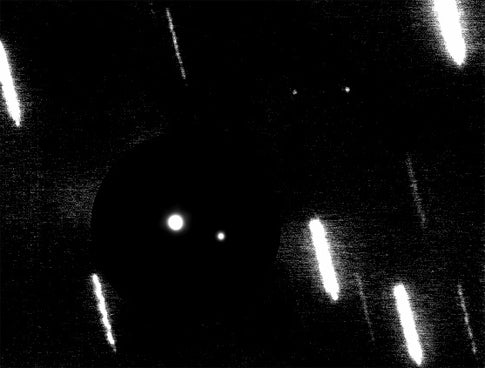Almost 30 years after the discovery of Pluto’s large moon, Charon, a University of Hawaii astronomer has used a ground-based telescope to take an image of the Pluto system that exceeds the sharpness possible with the Hubble Space Telescope.
“Several favorable factors occurred simultaneously to yield these spectacular images of the Pluto system,” said Dr. David Tholen, who performed the observations during the early evening of September 5 using the adaptive optics system on one of Mauna Kea’s twin Keck telescopes. “The natural seeing was better than average that night, more sensitive wavefront sensors were installed on the telescope, and Pluto was at its maximum brightness, thereby giving the improved adaptive optics system more light with which to work its magic,” he said.
The adaptive optics system uses a deformable mirror and sensors that allow it to compensate for turbulence in Earth’s atmosphere that normally blurs the light from celestial bodies. The new images, which have a resolution of about 35 milliarcseconds, are nearly diffraction limited at the 1.6-micron wavelength used for the exposures. They are about 20 times sharper than the images of Pluto taken 30 years ago.
Altogether, Tholen took 16 images of the Pluto system during one hour on the Keck telescope. When he combined all 16 images to form a single image, Nix and Hydra, Pluto’s small satellites discovered with the Hubble Space Telescope in 2005, became clearly visible. The new satellites are both about visual magnitude 23.5 compared with 14th magnitude for Pluto.
“It is our intent to obtain several more images of the Pluto system, hopefully with this same level of quality, so that we can track Nix and Hydra completely around Pluto several times,” said Tholen. “By making extremely precise measurements of the satellites’ positions, we will determine their masses by detecting the tiny displacements caused by their mutual gravitational attraction. Once the masses are in hand, we’ll be able to say something more definitive about how big these new satellites are.”
Astronomers have estimated that Nix and Hydra are less than 100 km in diameter, compared with 1212 km for Charon and about 2300 km for Pluto. Scientists planning the 2015 flyby of Pluto with NASA’s New Horizons spacecraft are intensely interested in the results. “Something as simple as selecting the proper exposure time to snap images of Nix and Hydra with New Horizons depends on knowing how big they are and how reflective their surfaces are,” said Tholen. “One of our goals is to have those answers well in advance of the flyby.”










